
Chandra, also known as Soma, is the Hindu god of the Moon, and is associated with the night, plants and vegetation. He is one of the Navagraha and Dikpala.

In Indian religions, a rishi is an accomplished and enlightened person. They find mentions in various Vedic texts. Rishis are believed to have composed hymns of the Vedas. The Post-Vedic tradition of Hinduism regards the rishis as "great yogis" or "sages" who after intense meditation (tapas) realized the supreme truth and eternal knowledge, which they composed into hymns. The term appears in Pali literature as Ishi and in Buddhism, they can be either Buddhas, Paccekabuddhas, Arahats or a monk of high rank.

Saraswati is the Hindu goddess of knowledge, music, art, speech, wisdom, and learning. She is one of the Tridevi, along with the goddesses Lakshmi and Parvati.

In the Shaivism tradition of Hinduism, the goddess Tara is the second of the ten Mahavidyas. She is considered a form of Adishakti, the tantric manifestation of Parvati. Her three most famous forms are Ekajaṭā, Ugratara, and Nīlasarasvatī. Her most famous centre of worship is the temple and the cremation ground of Tarapith in West Bengal, India.

A mudra is a symbolic or ritual gesture or pose in Hinduism, Jainism and Buddhism. While some mudras involve the entire body, most are performed with the hands and fingers.
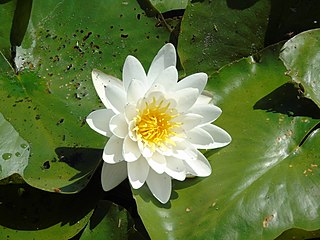
Nymphaea is a genus of hardy and tender aquatic plants in the family Nymphaeaceae. The genus has a cosmopolitan distribution. Many species are cultivated as ornamental plants, and many cultivars have been bred. Some taxa occur as introduced species where they are not native, and some are weeds. Plants of the genus are known commonly as water lilies, or waterlilies in the United Kingdom. The genus name is from the Greek νυμφαία, nymphaia and the Latin nymphaea, which mean "water lily" and were inspired by the nymphs of Greek and Latin mythology.
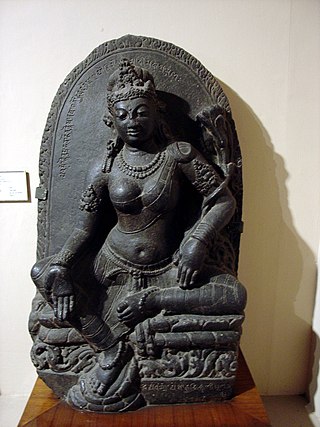
Tara, Ārya Tārā, or śyāmatārā, also known as Jetsün Dölma, is an important figure in Buddhism, especially revered in Vajrayana Buddhism, Navayana Buddhism, and Mahayana Buddhism. She appears as a female bodhisattva in Buddhism, and as a female Buddha in Vajrayana Buddhism. She is known as the "mother of liberation", and represents the virtues of success in work and achievements. She is known as Duōluó Púsà (多羅菩薩) in Chinese Buddhism, and as Tara Bosatsu (多羅菩薩) in Japan.

Trailokya literally means "three worlds" It can also refer to "three spheres," "three planes of existence," "three realms" and "three regions."
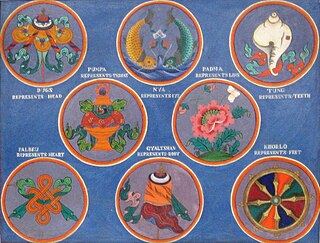
The Ashtamangala is a sacred suite of Eight Auspicious Signs featured in a number of Indian religions such as Hinduism, Jainism, and Buddhism. The symbols or "symbolic attributes" are yidam and teaching tools. Not only do these attributes point to qualities of enlightened mindstream, but they are the investiture that ornaments these enlightened "qualities". Many cultural enumerations and variations of the Ashtamangala are extant.
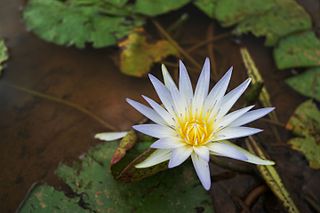
Nymphaea nouchali var. caerulea, is a water lily in the genus Nymphaea, a botanical variety of Nymphaea nouchali.

Kaumodaki is the gadā (mace) of the Hindu deity Vishnu. Vishnu is often depicted holding the Kaumodaki in one of his four hands; his other attributes are the chakra, the conch and the lotus. The gada is also found in the iconography of some of Vishnu's avatars.

The lotus, Nelumbo nucifera, is an aquatic plant that plays a central role in the art of Indian religions such as Hinduism, Buddhism, Jainism and Sikhism.

Ficus racemosa, the cluster fig, red river fig or gular, is a species of plant in the family Moraceae. It is native to Australia and tropical Asia. It is a fast-growing plant with large, very rough leaves, usually attaining the size of a large shrub, although older specimens can grow quite large and gnarled. It is unusual in that its figs grow on or close to the tree trunk, termed cauliflory.
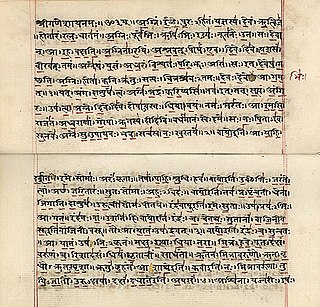
Svādhyāya is a Sanskrit term which means self-study and especially the recitation of the Vedas and other sacred texts. It is also a broader concept with several meanings. In various schools of Hinduism, Svadhyaya is a Niyama connoting introspection and "study of self".
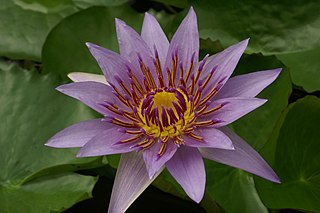
Nymphaea nouchali var. zanzibariensis is a variety of the water lily species Nymphaea nouchali Burm.f. naturally found in the region stretching from Southeastern Kenya to Southern Africa, including the Comoros and Madagascar. It has been Introduced into Florida, USA.

In Buddhism, udumbara refers to the tree, flower and fruit of the Ficus racemosa. In Buddhist literature, this tree or its fruit may carry the connotation of rarity and parasitism. It is also mentioned in Vedic texts as the source of wood for rituals and amulets.

Nymphaea nouchali, often known by its synonym Nymphaea stellata, or by common names blue lotus, star lotus, red water lily, dwarf aquarium lily, blue water lily, blue star water lily or manel flower, is a water lily of genus Nymphaea. It is native to southern and eastern parts of Asia, and is the national flower of Bangladesh and Sri Lanka. In Sanskrit, it is utpala. This species is usually considered to include the blue Egyptian lotus N. nouchali var. caerulea. In the past, taxonomic confusion has occurred, with the name Nymphaea nouchali incorrectly applied to Nymphaea pubescens.

Lalitasana is a pose or mudra in Indian art and the art of dharmic religions in other countries. It is often called "the royal position" or "royal ease" in English, and is a relaxed pose typical in royal portraits and those of religious figures whose "kingly" attributes are being emphasized. The figure sits on a throne with one leg tucked inwards on the seat and the other hanging down ("pendent") to touch the ground or rest on a support. Usually it is the proper right leg that dangles, but the reversed image can be found. Bare feet are normal. Asana is a general term for a seated pose, from Sanskrit: आसन āsana "sitting down", a sitting posture, a seat.

The lotus throne, sometimes called lotus platform, is a stylized lotus flower used as the seat or base for a figure in art associated with Indian religions. It is the normal pedestal for divine figures in Buddhist art and Hindu art, and often seen in Jain art. Originating in Indian art, it followed Indian religions to East Asia in particular.

Poshak (पोशाक), also called Vāstra (वस्त्र) is the Hindi term used for the complete attire used in the vedic period. As mentioned in Sanskrit literature and Buddhist Pali literature during the 6th century BC, the costumes belonging to the Vedic and post-Vedic period 1500 BCE to 350 BCE consisted of the antariya, which is the lower garment, the uttariya, which is a veil worn over the shoulder or the head, and the stanapatta, which is a chest band. The modernday Sari is one of the evolved poshak earlier known as Sattika that was single garment to wrap around the waist and cover the head.





















